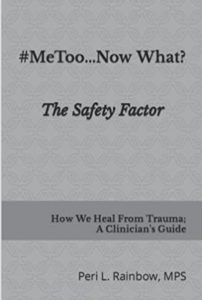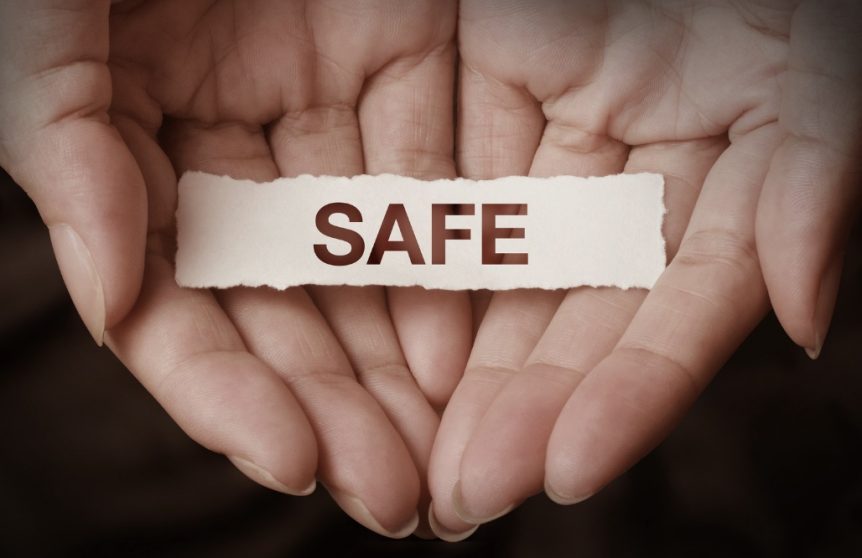
Peri L. Rainbow, MPS, is an author, clinician, educator, activist, and survivor of sexual and physical assault. Her newest book, “#MeToo…Now What? The Safety Factor,” illustrates her struggles and epiphanies in her recovery process and highlights the need for trauma-informed treatment and societal reform. Her book serves as a practical guide for practitioners and those suffering from traumatic events and poses the question: “what happens when society itself is the perpetrator?”
In sharing her story, she recounts a therapy session from her early days seeking recovery from trauma. The session left her feeling triggered and unsafe, and the experience helped her recognize the importance of trauma-informed treatment that she currently uses with her clients.
“Like so many other survivors, though, I was mostly left to figure out things on my own. Thus, I began my personal journey and professional career in the treatment of post-traumatic stress” #MeToo…Now What? The Safety Factor,(p. 69)
Why is Trauma-informed treatment so important?
“A Trauma-Informed approach to treatment attends to Internal Safety by reducing the surprises whenever possible and discussing, through psychoeducation, the safe ways someone can respond when feeling surprised.” #MeToo…Now What? The Safety Factor,(p. 81)
Trauma-informed treatment is crucial in protecting patients from retraumatization by creating trust and predictability within the sessions. Feelings of surprise or lack of control can trigger memories of helplessness and make the client feel the event is happening at the moment. This dynamic also contributes to further cynicism over the efficacy of the therapy and will prevent a client from continuing. Peri addresses some of the trauma-informed checkpoints a clinician must have in place before progressing with treatment:
Establish trust between the patient and practitioner
As Peri points out in “#Me Too…Now What?”, trauma survivors often trust no one or everyone. A trauma-informed practitioner understands this and works to create a trusting relationship before moving into vulnerable territories where clients may be sharing sensitive material.
Gage where the client is at in stages of treatment and move forward at the appropriate pace
Trauma-informed practitioners recognize when a client may be more receptive to addressing issues. She breaks down treatments into stages:
- Beginning: focused on building safety and coping skills and laying out expectations for the session
- Mid-treatment: uncovering details, recognizing that the present moment is safe
- End-treatment: discussing current goals in the scope of how trauma affects everyday decisions
The client must be prepared for each treatment stage and create as much predictability as possible
Receive confirmation and consent
To create clear expectations for the client, therapists need verbal consent and confirmation before touching the client or exploring any triggering material.
Establish the Three Domains of Safety
The client must feel safe in their environment, relationships, and internally in each session.
How can feelings of safety be developed in trauma healing?
Through patient case study examples, Peri outlines how security must exist in three domains for healing to occur: Environmental Safety, Relational Safety, and Internal Safety.
Environmental Safety provides safe and manageable surroundings with few surprises; this means living in and visiting environments that are stable and calm. In a therapeutic setting, this could mean letting a client sit facing the door to be aware of the space, being in an environment that limits sudden loud noises, and holding on to lucky charms for feelings of security.
Relational safety involves recognizing who a client can view as a trusted, listening ally. In a therapeutic relationship, this means developing trust as a practitioner, creating a space where the client feels heard and seen, and safe to witness their pain at the moment.
Internal safety sees that a person is successfully keeping a grounded “inner life”. Controlling racing thoughts, recognizing feelings of shame and knowing self-regulation tools support this domain.
How does ART fall into this model of Trauma-Informed Therapy?
Peri has referenced ART as an indispensable modality for trauma healing as it delicately manages all three Domains of Safety.
“ART creates “Environmental Safety” by positioning the client and clinician with intention. We attend to the seating arrangements, the distance between bodies, even the lighting and sound together as ART practitioners inform clients about the process and gain consent.
“Environmental Safety” leads to “Relational Safety,” as ART, unlike more traditional therapies, does not require the client/recipient to disclose or share their trauma without building the necessary trust. The client or recipient may share, however the choice or control over the process belongs to them, not the clinician, which creates and enhances “Internal Safety.” The ART clinician is the guide, and though the process is rigid and predictable (which enhances safety,) the client or treatment recipient is in charge.”
She cites ART as an integral part of her own and her clients’ recovery.
“I was the recipient of Accelerated Resolution Therapy for the treatment of PTSD resulting from childhood sexual abuse and neglect. In treatment, I safely entered my past and controlled each step I took in my mind’s eye, and in what way the imagery would change. I was able to see and know things I could not tolerate before, because the pain associated with those memories was lessened, almost gone. That pain caused symptoms of panic and anxiety resulting in a severe/chronic auto-immune condition. During treatment, I chose what images to see, what to feel and smell as the old memory surfaced. I still do because the memory is still there. The pain is not. That pain now feels more like sadness, the situation was sad, that is a fact. Remarkably though, due to ART, I can choose to stay there in that sadness or allow my mind to go to the place it created during treatment. It’s the place my brain wants to go, so I go with it. The memory of the trauma is still there. It is my history, and I would not want it erased.
ART allows the client/recipient to effortlessly choose a different path. We are no longer reacting to triggers that remind and then flood our senses. We are no longer symptomatic. The effects of trauma last forever. It is the essence of the traumatic experience, and one component that differentiates it from other experiences. ART is a cure because it can eliminate the symptoms associated with the disorder. The symptoms no longer dictate the lives of those treated with ART.”
 #MeToo…Now What? a “book about post-traumatic growth”, is available on Amazon.
#MeToo…Now What? a “book about post-traumatic growth”, is available on Amazon.
To find out how to connect with Peri L. Rainbow, MPS or an ART-trained practitioner near you visit https://acceleratedresolutiontherapy.com/therapist-directory/

